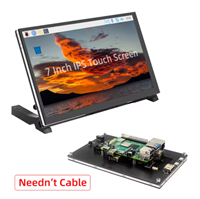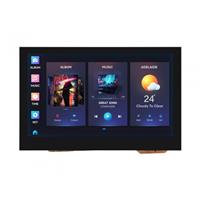|
|
ARDUINO_NANOnull
|
x 1 | |
|
|
74HCU04DToshiba
|
x 1 | |
|
|
DTC143ZMT2LROHM(罗姆)
|
x 1 | |
|
|
7805 |
x 1 | |
|
|
TQ2-5V ATQ209Panasonic
|
x 1 |

|
arduino IDEArduino
|
LC meter of using the franclin oscillator アルディーノマイコンを使ったLCメーター
This LC meter is majorly composed by 74HCU04 Franclin oscillator and Arduino frequency counter.
The east German engineer of Dr.Hegewald had published this LC meter design principal. AADE and some suppliers introduced the products for HAMs. At the original design they used PIC. (Such information is kept on VK3BHR web site"https://sites.google.com/site/vk3bhr/home/lcm1/faq?pli=1")
I followed this method by using Arduino to recognize the principal of L or C measuring.
I had posted my sketch on GITHUB("https://github.com/Nobcha/ArduinoLCM"). I also explained how to get the value by measuring frequency of LC circuit.
As the calculated value is based on the difference of the frequency, the parasitical component along the real oscillating circuit shall be avoided. And the gotten value is referenced on the precise sample. Also measuring frequency is nearly the practical usage. This meter can be worked precisely nevertheless the simple structure. Please refer my WEB for assembling.("http://chitose6thplant.web.fc2.com/LCM/Arduino_LCM_EXP.htm")
My sketch is merely simple and please modify for your preference.
Thanks for reading.
nobcha
74HCU04でフランクリン発振器を構成し、Arduino nanoで制御計算するLCメータです。ガーバーファイルや、スケッチなどはGITHUB("https://github.com/Nobcha/ArduinoLCM")にアップロードしてあります。詳しくはブログ("http://chitose6thplant.web.fc2.com/LCM/Arduino_LCM_EXP.htm")も参照ください。操作例は次のYOUTUBEにあります。
Please visit YOUTUBE to see how to use it. https://youtu.be/LxzoExQPcYk:embed:cite
// updated 2021.11.20 // Arduino LC meter V2.1 // // 2021.11.18 Franclin OSC timing // 2021.11.15 i2cLCD_PCF8574_0x27 // 2021.10.10 Adopted dtostrf for xxx.xxxuH, decrease delay value // 2021.09.17 Displaying with standard function Gate time 200ms // LC meter Arduino 2020.07.09, 20200716 f1 ok, 20200717 f2 ok // 20200718 xxxxxxxpF xxxxxuH OK // 20200718 if (test_value<1.000E+2) xxxxxnH OK // 2020.06.25 Frequency counter ; Many thanks for below sketch. // Sample sketch(FreqCount_2017-0207-001-ok) // "http://interface.khm.de/index.php/lab/interfaces-advanced/arduino-frequency-counter-library/" // Using Counter1 for counting Frequency on T1 / PD5 / digitalPin 5 // Using Timer2 for Gatetime generation // D5:FRQ input, D6:Driving the relay, D7:L/C select PINMODE setting // Replace calling name for i2cLCD // Based on PIC1827_main_c /************************************************* LC METER by PIC 1602 display by 4 bit with PIC16F1827 By nobcha all right reserved Ver 1.0 09/29/2010 for PIC16F88 Ver 2.0 for PIC16F428 Ver 3.0 02/10/2012 for PIC16F1827 Hitech C & MPLAB PIC16F1827 + LCD MPLAB IDE V8.73a HiTECH C V9.83 **************************************************/ #include <FreqCounter.h> #include <Wire.h> // AKIDUKI LCD[AQM0802A][AQM1602A] ST7032i // http://zattouka.net/GarageHouse/micon//Arduino/LCD/I2CLCD.htm #include <skI2CLCDlib.h> // For 0x3E AKIDUKI LCD // i2c lcd instance // Thanks for giving information about i2c LCD adapter // https://github.com/marcoschwartz/LiquidCrystal_I2C #include <LiquidCrystal_I2C.h> int PIN_Led = 13; // Gate timing LED lit port boolean LED_Stat = 1; // Gate ON/OFF timing LED int SEL_SW = 7; // L/C select SW boolean SEL_SW_Stat = 1; int CAL_ON = 6; // Caliblation relay int ON = 1; int OFF = 0; // ST7032 lcd instance skI2CLCDlib LCD(0x3E, 16); // LCD i2c address, display column 16 characters // initialize Serial, i2cLCD, PCF8574 LiquidCrystal_I2C lcdi2c(0x27,16,2); // Adress*0x27, 16 columns, 2 lines volatile unsigned long freq_d; volatile unsigned long freq; volatile boolean err; char charbuf[16]; // Character array for sprintf function volatile unsigned char i, l_power, l_digi, l_unit, c_power, c_digi, c_unit; volatile unsigned long freq1, freq2, freq3; volatile float c_int, l_int, l_inv, f_sq; volatile float c_cal=1.000e+3; volatile float test_value; volatile unsigned long freq_count() { FreqCounter::f_comp = 8; // Set compensation to 12 FreqCounter::start(200); // Start counting with gatetime of 200ms while (FreqCounter::f_ready == 0); // wait until counter ready freq_d = FreqCounter::f_freq; // read result Serial.println(freq_d); // 20210917 print freq_d@200ms if(freq_d<2000) err=1; // ?? too low, less than 10kHz return freq_d; // } float freq_cal(unsigned long f1, unsigned long f2){ // Coefficient calculating return((float)(f1)/(float)(f2)*(float)(f1)/(float)(f2)-1); } void LCDSetCursor( int column, int line ) { LCD.SetCursor( column, line ); lcdi2c.setCursor( column, line ) ; } void LCDPuts( char *const s ) { LCD.Puts( s ) ; lcdi2c.print( s ) ; } void setup() { Serial.begin(9600); // connect to the serial port Serial.println("LCM on i2cLCD v2.0"); // Version 2.0 pinMode(PIN_Led, OUTPUT); pinMode(SEL_SW, INPUT); pinMode(CAL_ON, OUTPUT); // Initializing LCD mojule // ICON OFF,contrast setting(0-63),VDD=5V LCD.Init(LCD_NOT_ICON,32,LCD_VDD5V) ; //Change to 5V on 20200612 // PCF8574 LCD // Iniatilize i2c LCD lcdi2c.init(); lcdi2c.backlight(); delay(100); // Write LCDSetCursor(0,0) ; // Starting point [00H] LCDPuts("LCM METER ") ; // [00H] Serial.println( "TEST2" ); delay(20); LCDSetCursor(0,1) ; // 2nd line [40H] LCDPuts(" i2cLCD v2.0 ") ; // [40H] delay(20); } void loop() { // START SWITCH CHECK // If caliblration Serial.println("WAIT SEL SW ON"); while( digitalRead(SEL_SW) == 0 ){ } // CAL switch check delay(20); while( digitalRead(SEL_SW) == 0 ){ } // Check again delay(200); /* Get frequency 1 and display */ Serial.println("SEL SW ON"); freq1=freq_count(); // F1 get freq1=5*freq_count(); // F1 get again as freq_count() // result is based on 200ms gate Serial.println("F1 gotten"); Serial.println(freq1); LCDSetCursor(3,0) ; // Display position set on 4th column LCDPuts(" f1="); sprintf( charbuf,"%ld", freq1, 7); LCDPuts(charbuf); LCDPuts("Hz "); // // Relay on f2 getting digitalWrite( CAL_ON, ON); // Calibration capasitor on delay(200); // Wait 100ms freq2=freq_count(); // Get F2 freq2=5*freq_count(); // Get F2 digitalWrite( CAL_ON, OFF); // Calibration capasitor off Serial.println("F2 gotten"); Serial.println(freq2); /* F2 displaying */ LCDSetCursor(0,1); // Move cursur to the top of 2nd line LCDPuts("f2="); sprintf( charbuf,"%ld", freq2, 7); LCDPuts(charbuf); LCDPuts("Hz "); // delay(50); /* Calculating C and L */ c_int=(float)(c_cal)/freq_cal(freq1,freq2); // Calcurate c_int from F and F2 pF f_sq=(float)(freq1)*(float)(freq1)/+1.000E+2; // (F1*F1) Serial.println("freq_cal= "); Serial.println(freq_cal(freq1,freq2)); l_inv=(+3.9438E+1)*f_sq*c_int; // l_int=(+1.000E+16)/l_inv; // uH /* for debugging */ Serial.println("C/L unit gotten"); Serial.println("C="); Serial.println(c_int); Serial.println("L="); Serial.println(l_int); LCDSetCursor(0,1); // Move cursur to the top of 2nd line LCDPuts("C="); sprintf( charbuf,"%d", (int)c_int); LCDPuts(charbuf); LCDPuts("pF "); // LCDPuts("L="); sprintf( charbuf,"%d", (int)l_int); LCDPuts(charbuf); LCDPuts("uH "); // // Calibration finished Serial.println("Calibration end "); LCDSetCursor(3,0) ; // Move cursur to the 4th of 1st line LCDPuts(" Calibrated "); delay(1000); // Measurement starting check while( digitalRead(SEL_SW) == 1 ){ } // Wait sw status changed while (1) // Testing forever { digitalWrite(PIN_Led, LED_Stat=!LED_Stat); // LED on/off delay(100); LCDSetCursor(4,0); // Move cursur to the 8th of 1st line LCDPuts("SET TEST "); // Ask setting L or C delay(300); freq3=freq_count(); // Get F3 freq3=5*freq_count(); // Get F3 Serial.println("F3 gotten"); Serial.println(freq3); LCDSetCursor(3,0); // Move cursur to the top of 2nd line LCDPuts(" f3="); sprintf( charbuf,"%ld", freq3, 7); LCDPuts(charbuf); LCDPuts("Hz"); // delay(100); /* displaying value */ LCDSetCursor(0,1); // Move cursur to the top of 2nd line /* Metric unit changing further study */ /* uH/mH l_power=1; mH, l_power=1000; uH, pF/uF c_power=1; pF, c_power=1000; nF, */ l_power=1; l_digi=1; l_unit='u'; c_power=1; c_digi=0; c_unit='p'; /* Calculating value whether C position or L */ if(digitalRead(SEL_SW) == 0) // If SW==0, start L measuring { // L position if ( freq3> 1000 ){ test_value= ((freq_cal(freq1,freq3))*l_int); int f_rate = (freq_cal(freq1,freq3)*1000); Serial.println("f_rate"); Serial.println(f_rate); LCDPuts("L="); dtostrf( test_value, 7, 3, charbuf); // Changed to use dtostrf(**) LCDPuts(charbuf); LCDPuts("uH "); /* sprintf( charbuf, "%d", (long) test_value ); LCD.Puts(charbuf); LCD.Puts("uH "); if (test_value<1.000E+2) { LCD.SetCursor(0,1); // Move cursur to the top of 2nd line LCD.Puts("L="); sprintf( charbuf, "%d", (long) (test_value*1.0E+3 )); LCD.Puts(charbuf); LCD.Puts("nH "); } */ Serial.println("L="); Serial.println( test_value); Serial.println("uH"); } else { LCDPuts(" No inducter ") ; Serial.println( " No inducter "); } } else { test_value=((freq_cal(freq1,freq3))*c_int/c_power); Serial.println("C="); Serial.println( test_value); Serial.println("pF"); LCDPuts("C="); sprintf( charbuf, "%u", (long) (test_value )); LCDPuts(charbuf); LCDPuts("pF "); } delay (500); } }


LC meter of using the franclin oscillator アルディーノマイコンを使ったLCメーター
*PCBWay community is a sharing platform. We are not responsible for any design issues and parameter issues (board thickness, surface finish, etc.) you choose.

Raspberry Pi 5 7 Inch Touch Screen IPS 1024x600 HD LCD HDMI-compatible Display for RPI 4B 3B+ OPI 5 AIDA64 PC Secondary Screen(Without Speaker)
BUY NOW
ESP32-S3 4.3inch Capacitive Touch Display Development Board, 800×480, 5-point Touch, 32-bit LX7 Dual-core Processor
BUY NOW
Raspberry Pi 5 7 Inch Touch Screen IPS 1024x600 HD LCD HDMI-compatible Display for RPI 4B 3B+ OPI 5 AIDA64 PC Secondary Screen(Without Speaker)
BUY NOW- Comments(0)
- Likes(7)
 Log in to post comments.
Log in to post comments.
-
 Anthony Pedotto
Feb 22,2025
Anthony Pedotto
Feb 22,2025
-
 micbanand
Nov 03,2024
micbanand
Nov 03,2024
-
 Engineer
Apr 22,2024
Engineer
Apr 22,2024
-
 Engineer
Apr 14,2024
Engineer
Apr 14,2024
-
 Engineer
Sep 02,2023
Engineer
Sep 02,2023
-
 Engineer
Dec 08,2022
Engineer
Dec 08,2022
-
 HA8IG Op.Imre
Dec 07,2022
HA8IG Op.Imre
Dec 07,2022
- 0 USER VOTES
- YOUR VOTE 0.00 0.00
- 1
- 2
- 3
- 4
- 5
- 6
- 7
- 8
- 9
- 10
- 1
- 2
- 3
- 4
- 5
- 6
- 7
- 8
- 9
- 10
- 1
- 2
- 3
- 4
- 5
- 6
- 7
- 8
- 9
- 10
- 1
- 2
- 3
- 4
- 5
- 6
- 7
- 8
- 9
- 10
 More by Nobuteru Asai
More by Nobuteru Asai
-
-
Commodore 64 1541-II 1581 Floppy Disk Drive C64 Power Supply Unit USB-C 5V 12V DIN connector 5.25
381 1 3 -
-
-
-
-
-
-
-
Modifying a Hotplate to a Reflow Solder Station
1252 1 6 -
MPL3115A2 Barometric Pressure, Altitude, and Temperature Sensor
712 0 1 -









































